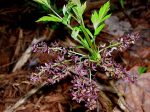 This small deciduous shrub is a member of the buttercup family, Ranunculaceae, that also includes anemone, columbine, and delphinium. It is native to damp woods and stream edges in eastern US mostly in the Appalachians from New York, south to Florida and Louisiana. With a stoloniferous root system, the shrub forms large colonies up 8’ wide. The stems are sparsely branched and 1-3’ tall. Small star-like flowers dangle in chains Small, star-like yellow or brownish-purple flowers are carried in terminal pendant panicles in early spring before the leaves emerge. The leaves are spirally arranged, finely divided with 5 toothed leaflets, and turn yellow to bronze or red in the fall. Best fall color is when plants get ample sun. An excellent plant for erosion control, and wildlife habitat. The genus name, Xanthorhiza, comes from the Greek words xanthos meaning yellow and rhiza meaning root. The specific epithet , simplicissima, is the Latin word meaning the most/very simple. The common name, yellowroot, like the genus name, refers to the inner bark of the plant.
This small deciduous shrub is a member of the buttercup family, Ranunculaceae, that also includes anemone, columbine, and delphinium. It is native to damp woods and stream edges in eastern US mostly in the Appalachians from New York, south to Florida and Louisiana. With a stoloniferous root system, the shrub forms large colonies up 8’ wide. The stems are sparsely branched and 1-3’ tall. Small star-like flowers dangle in chains Small, star-like yellow or brownish-purple flowers are carried in terminal pendant panicles in early spring before the leaves emerge. The leaves are spirally arranged, finely divided with 5 toothed leaflets, and turn yellow to bronze or red in the fall. Best fall color is when plants get ample sun. An excellent plant for erosion control, and wildlife habitat. The genus name, Xanthorhiza, comes from the Greek words xanthos meaning yellow and rhiza meaning root. The specific epithet , simplicissima, is the Latin word meaning the most/very simple. The common name, yellowroot, like the genus name, refers to the inner bark of the plant.
Type: Shrub
Outstanding Feature: Fall color
Form: Forms colonies
Growth Rate: Rapid
Bloom: Terminal panicles of small star-like yellow or brownish purple in early spring
Size: 1-3’ H x 4-6’ W (colonies)
Light: Dappled shade but tolerates full sun to full shade
Soil: Average, moist, acidic but tolerates some drought and brief inundation
Hardiness: Zones 3-8
Care: Cut back in early spring to keep tidy.
Pests and Diseases: None of significance
Propagation: Division, root cuttings, spring shoot cuttings
Photo Credit: TheAlphaWolf, Wikipedia